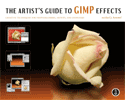
The Artist’s Guide to GIMP Effects
Michael J. Hammel
Published: No Starch Press
ISBN 978-1-59327-153-4
Paperback, 360 pages, $44.95
GIMP, or the GNU Image Manipulation Program to give it its proper name, is a graphics-editing program broadly similar to Adobe Photoshop in terms of functionality. The GIMP is an open source program that can be freely downloaded and installed on most computers, including maps. But on the downside it doesn’t come with a manual, so figuring out how to use GIMP can be tricky.
But ‘The Artist’s Guide to GIMP Effects‘ isn’t simply a book explaining what all the different tools and features do. Michael Hammel pitches this book quite a bit higher than that, focusing instead on how to use GIMP to perform a variety of useful and common tasks. From trick photography to building graphics for web sites, Hammel leads the reader expertly through nicely illustrated tutorials. The end result is more than simply a better understanding of the program, but a richer appreciation of what the program can be used to do.
There are six chapters, the first of which introduces many of the basic concepts. Although there is some attention given to where the relevant tools are found and how to use them, the focus here is on what they do and why you need them. Fundamental to success with any graphics program is understanding how different tools work when applied together, and Hammel finishes off this chapter with a set of multi-function tutorials that underline this point.
The second chapter concentrates on manipulating photographs. These include softening images, adding motion effects, and creating reflections. In each case the process is taken step-by-step, with clear text and relevant screenshots. At this point it’s also worth mentioning something about the layout of the book. No Starch has really done a good job here. The book is wider than it is tall, and each page holds two columns of text. The flexible binding lets the book stay open at any page. As a result, it’s an easy book to use alongside the computer.
The next chapter is about creating artwork for web sites. These include things like tiles for web page backgrounds, buttons, tabs, and menu bars. The first tutorial in this batch is all about creating glossy, gel-like buttons of the type Macintosh users will be familiar with. One of the later tutorials looks at the ubiquitous rollover buttons, though from the perspective of creating the actual artwork required rather than the necessary JavaScript or CSS coding. That said, if you use a WYSIWYG web page layout program like Freeway, you probably won’t need to manually any of that sort of code to your page anyway; all you need are the graphics.
Like all the other chapters, the web design chapter finishes with a collection of useful tips. Some of these should be required reading for any web designer, and it’s great to see the author lay them out fair and square.
The fourth chapter is very unusual but actually makes a lot of sense. It’s a chapter devoted to creating advertising. While no substitute for a degree in marketing, there’s some great stuff here for anyone who needs to produce things like packaging and posters. Small businesses attracted to GIMP by its low cost will likely find this chapter worth the price of the book alone. On the other hand, some of the tutorials in this section are only incidentally useful for advertising purposes though, and could be just as relevant to anyone creating computer artwork. Again, there’s a wrap-up section with a slew of useful tips and tricks.
Chapter five brings text into the mix. This chapter kicks off with some tutorials covering things like neon, metallic, and gel-like text, among other typographic effects.
The last chapter is specifically for software developers, and illustrates the ways in which GIMP can be used to design and prototype application interfaces. While a clever and potentially useful chapter, what was obviously missing from this section of the book was something on designing icons for programs. The book then rounds off with a detailed index.
For $45 this isn’t a cheap book, especially when you consider that GIMP itself is free and comes with its own online guides and tutorials. The question is whether having things laid out clearly and logically in a nicely illustrated book justifies the cost. In the opinion of this reviewer at least, the answer is yes. For the GIMP user looking to go beyond simply cropping and resizing digital images, this book is highly recommended.

Leave a Reply
You must be logged in to post a comment.